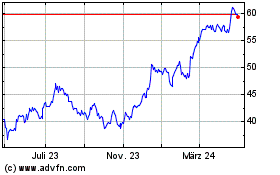By Rachel Louise Ensign
At 5 a.m. one day last February, construction work tripped a
sophisticated fire-extinguisher system in a Minnesota data center
used by Wells Fargo & Co., knocking out power to servers housed
in the building.
Customers soon noticed: the bank's online and mobile banking
systems were out for hours.
The outage brought into public view the technology failures that
have been occurring behind the scenes at Wells Fargo for years.
Antiquated systems have made it difficult for the bank to meet the
demands of regulators, who are closely scrutinizing the firm after
its 2016 fake-account scandal, according to more than a dozen
current and former employees.
The firm has struggled with tasks like monitoring employee pay
and building a new platform for financial advisers, hampering key
businesses.
"We need to be a technology company," Chief Executive Charles
Scharf said in his first meeting with employees after taking the
job in October. Saul Van Beurden, his head of technology and
another relatively new arrival, said in an interview that his top
priorities include fixing issues raised by regulators, attracting
talent and making sure key systems don't go offline again.
Banking was once a business of ornate branches and large vaults,
but the sector now runs on digital systems designed to move money
around, keep cybercriminals out and knit the disparate parts of
sprawling institutions together. Big banks spend billions on these
tools, employ tens of thousands of people to keep them running
smoothly and use flashy mobile apps to compete for customers.
Wells Fargo says it was the first U.S. lender to provide online
banking in the 1990s, a point of corporate pride. But it fell
behind in recent years, current and former employees say.
A spokesman said the bank has made a number of improvements to
its technology offerings, including card-free ATMs, contactless
debit cards and online mortgage applications.
In late 2015, the year before the fake-account scandal erupted,
the bank announced the departure of its chief information officer,
who reported to the CEO. The bank didn't replace the tech chief and
distributed his direct reports to other executives, including an
administrative head later placed on leave after regulators
reprimanded her for oversight failures.
The reporting structure at times could be disorganized.
Regulators, for instance, expect banks to keep meticulous records
of each stage of internal technology projects. In the unit
overseeing initiatives like Apple Pay, required documents were
often missing and the processes for creating them and checking they
were in place were largely manual, said Mark McAllister, a project
manager in the unit from 2014 to 2019.
Mr. McAllister said he was fired after raising concerns about
the lapses. The bank spokesman said Mr. McAllister wasn't
retaliated against, but declined to elaborate further.
By June 2018, regulators had identified problems across Wells
Fargo's tech operations, including software vulnerabilities,
cybersecurity concerns and risk-management inconsistencies, The
Wall Street Journal previously reported.
Last year, the Office of the Comptroller of the Currency told
Wells Fargo to improve its human-resources functions, including
technology systems. The agency in particular criticized the
division's manual processes for overseeing pay and performance for
its 260,000 employees, according to a person familiar with the
matter.
Legions of tech workers at the bank are toiling to satisfy
problems regulators have cited. Some relate to mundane topics like
improving systems that control employee building access, according
to another person familiar with the matter.
Other problems have affected customers, like the
online-and-mobile banking outage in early 2019. Wells Fargo said
construction work in a room of important servers tripped the fire
system, releasing extinguishing chemicals into the air, according
to public records from the local fire department. That triggered a
shutdown of power to servers, the bank said.
Issues at a single data center aren't supposed to knock out key
bank systems, which are meant to be routed to backups if they fail.
Bank employees believe backup systems weren't adequately tested to
make sure they would come online quickly if the suburban
Minneapolis data center had a problem, according to people familiar
with the matter.
Mr. Van Beurden joined Wells Fargo in April from JPMorgan Chase
& Co. and reports to Mr. Scharf. He said fixing the laundry
list of items cited by regulators is his "first priority." He's
also working to attract top software developers and cut down on the
time it takes to develop new technology.
Some of his projects were inspired by his former employers, like
an automated tool that predicts customer activity each day. That
helps the bank ensure that digital systems have the bandwidth to
handle busy days.
He said he has also made changes to prevent another outage, like
removing that particular type of fire-extinguisher system from data
centers. When "the app is down, the bank is down for our
customers," he said.
None of this is cheap. Executives have said that spending on
technology workers has been one reason expenses have remained
higher than the bank would like. Mr. Van Beurden last summer asked
outside consultants to refund some of the money the bank has
spent.
He has also shelved some long-running projects. In 2015, the
bank agreed to buy outside software that would replace old
technology used by its financial advisers. The new platform would
store wealth-management clients' data, making it easier for
employees to analyze.
The cost of the initiative ballooned, according to one person
who worked on it. Last year, the bank suspended the project,
according to the software provider, which cited the bank's "need to
change priorities."
Write to Rachel Louise Ensign at rachel.ensign@wsj.com
(END) Dow Jones Newswires
January 11, 2020 05:44 ET (10:44 GMT)
Copyright (c) 2020 Dow Jones & Company, Inc.
Wells Fargo (NYSE:WFC)
Historical Stock Chart
Von Mär 2024 bis Apr 2024

Wells Fargo (NYSE:WFC)
Historical Stock Chart
Von Apr 2023 bis Apr 2024
